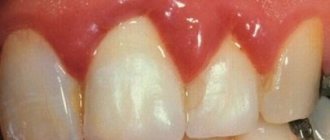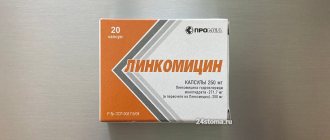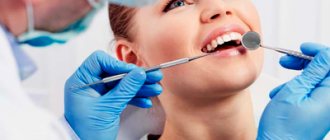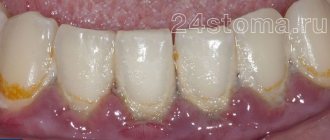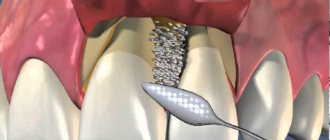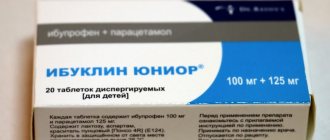It is believed that periodontal inflammation develops with the participation of periodontopathogenic microorganisms, the action of which manifests itself when the balance between the protective forces of the human body, organs and tissues of the oral cavity and bacterial infection is disturbed [11, 19]. Of all the branches of periodontology, practitioners are certainly most interested in the issues of adequate and effective drug treatment of inflammatory periodontal diseases.
Unfortunately, in the treatment of periodontal diseases there is no multidisciplinary approach, and internists are rarely involved in the treatment process. Usually, so-called monotherapy is carried out, in which a specialist of one profile is involved - usually a dentist-therapist. With the so-called complex treatment, all stages are carried out in random order, in the absence of an algorithm for complex therapy, without clear preliminary planning and subsequent objective assessment of the effectiveness of each stage, taking into account the individual characteristics of the patient, without a medical examination program and supportive therapy [1, 21].
The purpose of this message is to inform dentists specializing in periodontology, interns, clinical residents, senior dental students about the main directions of drug therapy for inflammatory periodontal diseases, which are most widely used today in Russia.
Based on our own experience and data from domestic literature, we can propose the following course of action for the dentist.
The authors have made every effort to ensure the accuracy of the information presented, including drug dosages. Aware of our responsibility associated with the preparation of the publication, and taking into account the constant changes occurring in medical science, we recommend that the dosage of medications be updated according to the appropriate instructions.
Indications for the use of antibiotics in dentistry
The need for treatment with antibiotics depends on the nature of the infection and the body's ability to withstand the course. The main reasons for prescribing antibiotics include:
- When advanced caries threatens pulpitis, the dentist may prescribe antibiotics to limit the spread of the pathological process. The patient is prescribed antihistamines to complement the effectiveness of antibiotics.
- With the development of an inflammatory process of periodontal tissue (periodontitis), antibiotic therapy allows the destruction of protozoa, gram-negative anaerobes in the oral cavity. Various dosage forms of drugs are used for treatment: gels, ointments, intramuscular and intravenous injections, tablets.
- The proliferation of pathogens, poor immunity, caries and dense plaque can lead to the development of gingivitis. After laboratory detection of the sensitivity of microbes to the antibiotic, a course of treatment is prescribed. Antibiotic drugs are mainly used for catarrhal gingivitis.
- The appearance of purulent accumulations inside the oral mucosa provokes the appearance of a fistula. The process occurs due to the proliferation of anaerobic gram-negative bacteria, streptococci, staphylococci, Pseudomonas aeruginosa or Escherichia coli. A doctor-prescribed course of antibiotics, which are also used for dental implantation, will help cope with the infection.
- Inflammation of the connective tissue around the root of the tooth is called periodontitis. The occurrence of the disease is a consequence of dental trauma, a complication of pulpitis, caries, or an error in dental treatment. If the process is not stopped, pus may appear. The effectiveness of antibiotics for periodontal disease is felt after preliminary cleaning of the periodontal tissue.
- The result of inflammation of various origins can be a granuloma - a cavity of granulation tissue filled with fluid. Location: on the gum near the root of the tooth. It is important to start treating granuloma in the early stages. The use of antibiotics facilitates the opening of the granulosa vesicle and suppresses the infection accumulated in it, and serves to prevent infection. Self-medication with antibacterial drugs is unacceptable.
Chronic endometritis and pregnancy
As mentioned earlier, with chronic endometritis, infertility or recurrent miscarriage is often observed. It is necessary that the endometrial layer is constantly regenerated: only then will the embryo be successfully implanted into the uterus. In chronic endometritis, regeneration is impossible due to the inflammatory process, so the fertilized egg cannot attach to the endometrium.
Even if this happens, the pregnancy is rarely successful: the risk of miscarriage will continue throughout pregnancy. Such a pregnancy is accompanied by disorders and complications: in particular, pathogens can infect fetal tissue, which will lead to its death.
Impaired embryo development is another possible consequence of pregnancy with endometritis. The damaged endometrium lacks blood supply due to stagnation: the tissue does not receive oxygen, vitamins, nutrients and does not transfer them to the embryo. Because of this, the child may be born with pathologies. In addition, the likelihood of premature birth increases several times; the formation of the placenta may be disrupted, so when planning a pregnancy, treatment for this disease should be started immediately.
In total, miscarriages and infertility due to chronic endometritis are associated with several reasons:
- Violation of the morphology of the endometrium, due to which the fertilized egg is not fixed in the uterus and is released along with the discharge - in this case, the woman may not even know that she was pregnant.
- Problems with progesterone synthesis: This hormone maintains pregnancy by thickening the endometrium and preparing the uterine lining. In chronic endometritis, progesterone is produced poorly, and pregnancy is terminated early.
- Male sperm are inactivated already at conception. During inflammation, phagocytic cells of the body destroy foreign bodies, which are also mistaken for sperm.
Therefore, before planning a pregnancy, it is necessary to undergo a full course of treatment for endometritis: in this case, the probability of becoming pregnant can increase to 100%. In the case of IVF, the main problem is related to the fixation of germ cells in the uterus, so for efficiency it is worth making several attempts to implant a fertilized egg. In addition to taking medications, you need to take care of yourself: try to eliminate stress, limit physical activity and not lift heavy objects.
Types of antibiotics for toothache
Doctors use antibiotics in dentistry, which have a wide range of applications, to stop the growth and reproduction of mixed bacterial infections in the oral cavity. Drugs are divided into the following types:
Should I take an antibiotic for dental inflammation?
What to do if the gums become inflamed after the removal of a wisdom tooth, due to trauma, or with advanced caries? How to treat a complicated form of periostitis and periodontitis? The effectiveness of therapy largely depends on the selection of the optimal type of antibacterial drug to suppress the pathological process. It is useful to know when an antibiotic is prescribed for dental inflammation, which groups of drugs are most often used in dental practice.
What is a dental cyst?
Tooth cyst - what is it? An odontogenic cyst is a pathological neoplasm that occurs in the upper part of the tooth root. The internal cavity of the cyst is filled with liquid or mushy purulent contents; it is enveloped by a dense layer of epithelium.
The size of the cyst starts from a few millimeters, with rapid development reaching several centimeters in circumference. Most often, the pathological process affects the upper jaw, since the roots of its teeth have a more porous structure.
In order to understand what a dental cyst is and how to treat it, you need to know why such a phenomenon occurs. The formation of cysts occurs as a result of inflammation, thus the body restricts healthy tissue from the affected areas, clogging them along with bacteria into bubbles.
How to use an antibiotic for tooth inflammation with pus
At the first stage, while the pathological process is less active, rinses with an antibacterial effect are carried out as prescribed by the dentist.
Local medications act directly on the affected area and are less absorbed into the systemic circulation, which reduces the risk of side effects.
You need to crush the tablets of Lincomycin, Azithromycin or Tetracycline, combine them with lukewarm (not hot) boiled water, and rinse your mouth with the solution. The proportions of the components are selected by the dentist.
Active inflammatory process in the periosteum and gums after removal of the problem unit, with infection from the outside or hematogenously, flux is an indication for the prescription of antimicrobial compounds. It is important to prevent complications that develop when purulent masses accumulate or exudate exits into the oral cavity through the fistula. With the flow of blood and lymph, infectious agents penetrate into other parts of the body.
Periodontitis and periostitis in acute or chronic form are dangerous diseases. To heal the wound, the dental surgeon first cleans the affected area, removes a thick mass containing pathogens, particles of blood and mucus. The second stage is the prescription of antibacterial drugs. For purulent inflammation, penicillins show high effectiveness: Amoxicillin, Amoxiclav. Depending on the severity of the pathological process, antibiotics are taken orally or given injections.
If an odontogenic infection is detected, against which the gums fester, the use of the drugs Gentamicin, Grammidin C, Ciprofloxacin, Cifran is indicated.
Diagnosis of gingivitis and treatment strategy
The dentist’s tactics when identifying inflammatory periodontal pathology includes the following aspects:
- situational analysis of data from questioning, examination, assessment of the patient’s general condition;
- creating a diagnostic hypothesis (the so-called preliminary diagnosis);
- refusal of early prescription and use of systemic drugs until the diagnostic hypothesis is confirmed (or excluded) and a clinical diagnosis is established;
- establishing a clinical diagnosis;
- development of a plan of treatment and preventive measures;
- informed choice of systemic and locally acting drugs, taking into account the nature of periodontal pathology and their clinical manifestations;
- medical examination of the patient.
At the stage of treatment of patients with inflammatory periodontal diseases, a sequence of measures is necessary, including:
- teaching patients the rules of individual oral hygiene;
- measures for professional oral hygiene;
- local use of drugs that have antibacterial and anti-inflammatory effects, affecting microcirculation in the periodontium (Table No. 1);
- elimination of factors that adversely affect the periodontium and aggravate the pathogenic effect of the microflora of the oral cavity and periodontal pockets on it.
Table No. 1. Antibacterial drugs, doses for adults and duration of use [18, 22].
Antibacterial drug | Doses for adults (body weight 70 kg) | Duration of use |
| Tetracycline | 4 times a day 250 mg | 14-21 days |
| Doxycycline | 1 time per day 200 mg per day, then 100 mg per day | 1, 13-20 days |
| Monocycline | 200 mg first dose, then 100 mg 2 times a day | 2-3 weeks |
| Amoxicillin with clavulanic acid (Augmentin, Amoxiclav) | 3 times 625 mg | 7-10 days |
| Ciprofloxacin | 2 times 500 mg | 7 days |
| Azithromycin | On the 1st day 500 mg, on subsequent days 250 mg | 7 days |
| Lincomycin | 2 times a day, 500 thousand units | 10-15 days |
| Clindamycin | 4 times 300 mg | 10 days |
| Amoxicillin | 1 time per day 500 mg per day | 7-10 days |
| Sumamed | 1 time per day 500 mg | 3-5 days |
| Rulid | 2 times a day 150 mg | 10 days |
| Metronidazole | 3 times a day 250-500 mg | 7-10 days |
| Metronidazole + amoxicillin | 3 times a day 250-500 mg metronidazole + 250 mg amoxicillin | 8 days |
| Ampicillin | 4 times a day, 500 mg in combination with metronidazole, 200-250 mg 3 times a day | |
| Erythromycin | 4 times a day, 500 mg in combination with metronidazole, 200-250 mg 3 times a day | |
| Roxithromycin | 2 times a day |
Modern tactics of media treatment of inflammatory periodontal diseases are carried out taking into account the role of oral microflora, biofilm, the presence of periodontal pockets and must necessarily include mechanical removal of supra- and subgingival dental deposits and other measures included in the treatment complex (Table No. 2).
Table No. 2. Antiseptic preparations used for rinsing the mouth and treating periodontal pockets [10].
Name of the drug | Breeding |
| Potassium permanganate | 1:1000—1:10000 |
| Furacilin | 1:5000 |
| Etonium solution | 0,5 % |
| Chloramine | 0,25 % |
| Chlorhexidine bigluconate (Corsodil mouthwash) | 0,05-0,12 % |
| Dioxidine | 1 % |
| Hydrogen peroxide solution | 0,5—1 % |
| Iodine solution | 0,1—0,5—1,0 % |
| Sodium hypochlorite solution | 0,1 % |
| Miramistin solution | 0,01 % |
The choice of medications for periodontal diseases depends on the severity of the inflammatory process, tissue swelling, gum bleeding, the presence of epithelial defects, the stage of the process and destructive changes in the lesion [3]. In modern dentistry, in case of inflammatory periodontal diseases, great importance is attached to maintaining a balance between the microflora and the protective systems of the oral cavity.
In order to correct the composition of microflora, broad-spectrum antiseptics have been proposed: chlorhexidine, triclosan, hexetidine, which are included in many oral hygiene products - rinses, gels, balms, toothpastes (Table No. 2). Many of them also contain herbal medicines. An example of such a combination is eucalyptus gel immobilized on polysorb. Local application of this drug is carried out in the form of applications on thin cotton wool, inserted into periodontal pockets for 20 minutes.
In the last decade, the modern development of the pharmaceutical industry has ensured the constant supply of new antiseptics to the consumer market, but products potentially evaluated for use in dental practice must meet the necessary requirements: have a wide spectrum of antibacterial action, low toxicity, and a low likelihood of developing microbial resistance [8].
Treatment of catarrhal gingivitis
In the presence of a pronounced inflammatory process, it is necessary to apply local antimicrobial and anti-inflammatory drugs in the form of applications, irrigations, medicinal dressings at a doctor's appointment (for example, Metrogyl-Denta - a gel with metronidazole and chlorhexidyl) and mouth rinses at home (for example, Corsodil "- a concentrated solution of chlorhexidine for preparing liquid before rinsing the mouth; infusion of chamomile, sage, etc.).
To improve epithelization processes, keratoplasty agents are used: fat-soluble vitamins A, E, sea buckthorn and rosehip oil, caratolin, solcoseryl.
General treatment. To normalize metabolism, the general reactivity of the body and its antioxidant protection, and stimulate tissue regeneration processes, vitamins and adaptogens can be used. The most commonly used vitamins are A, C, P, E, B vitamins and vitamin complexes (Multitabs, Aevit, Duovit, Complivit, Tetravit, Vitrum, Spectrum, etc.), combined preparations containing vitamins and microelements, other substances (olazol, aekol). It is necessary to remember the side effects and contraindications to the use of these drugs [10].
Names of antibiotics used for inflammation of the dental nerve and root
The dentist prescribes medications to suppress infection based on the results of an examination of the problem area. When the nerve is inflamed, it is difficult to eat and drink; throbbing or aching pain accompanies a person throughout the day and intensifies at night.
Before starting therapy, the doctor conducts an allergy test and interviews the patient to identify contraindications.
Antibiotics help eliminate inflammation of the root and dental nerve:
- Ciprofloxacin.
- Azithromycin.
- Amoxiclav.
- Azithromycin.
- Ampiox.
- Doxycycline.
- Digital
Main features
- Pain
In each case it can manifest itself differently. Sometimes it is pain when biting, sometimes it is continuous. It may get worse at night and subside with meals. It can radiate to the temple, ear, even nose. Being whiny or harsh.
- Redness
It may or may not be visible. This is a symptom that is more often detected by a doctor.
- Edema
Any inflammation is accompanied by swelling, but we cannot always determine this.
- Temperature increase
This doesn’t always happen, but fever is a sign of inflammation, so in this case you definitely shouldn’t put off going to the dentist.
- Tumor
This is also a dangerous signal; you need to see a doctor urgently.
If a tooth is inflamed and hurts, temporary measures will not help; you need a full diagnosis and treatment in a clinic. The alternative is tooth loss due to an advanced process.
List of effective antibacterial agents for dental infections under the crown
After endoprosthetics and implant installation, some patients complain of discomfort. Pain and inflammation are a consequence of a violation of the technology for fixing artificial teeth and crowns: the dentist did not completely fill the cavity inside the problem unit or mechanical damage to the canal walls occurred. If the implantologist is poorly qualified, the pin may be installed incorrectly. Perhaps the smallest parts from dental instruments remain inside the canal.
There are several causes of the pathological process and pain syndrome:
- swollen gums or gumboil (acute inflammation);
- cyst - a cavity with fluid near the root of a problematic unit of the dentition;
- inflammation of the submandibular salivary glands;
- dental granuloma;
- a fistula on the gum is a hole through which purulent masses are released.
With the development of inflammation in periodontal tissues, an abscess forms at the root apex. Painful sensations are a consequence of the active accumulation of exudate and pressure on neighboring areas.
The main condition for eliminating discomfort is a timely visit to the dentist to remove the crown, clean the root canals, and eliminate the cause of the inflammatory process. Uncontrolled use of antibiotics can harm the body.
Before treating the canals, the doctor makes an injection into the gum, removes the prosthesis, and examines the affected area.
Effective antibiotics are prescribed to suppress the infection:
After the removal of a wisdom tooth, there is an increased risk of not only inflammation, but also bleeding from the socket.
If the patient takes the drug Warfarin to prevent thrombosis, then you need to warn the dentist: the doctor temporarily stops taking the medication for several days before and after the extraction of the “eight”, be sure to coordinate this action with the cardiologist.
It is important to know how to combine an antithrombotic agent with antimicrobial compounds.
Types of pain relief
Dentists, as a rule, provide drug local anesthesia, which involves injecting the drug into the tissue in the treatment area. The effect of the product lasts for a certain time required by the specialist to perform the treatment procedure. After a short period of time, the drug is eliminated from the body, and tissue sensitivity is restored.
Treatment under general anesthesia is rarely performed. It is often used in complex jaw surgery operations.
Local anesthesia
Local anesthesia is almost always performed during dental treatment. It causes less stress to the body, so it is used even for children. A few years ago, only injections of Novocaine and Lidocaine were used. However, today different substances and their forms are used for pain relief.
- Application anesthesia
Anesthesia provides a superficial decrease in sensitivity. A special spray, gel or ointment is applied to the causative area of the oral cavity. A common substance is a solution of Lidocaine, produced in the form of an aerosol. This type of sensitivity reduction is indicated for manipulations with a minor degree of intervention, for example, when removing stone or preparing the dentition for prosthetics.
The concentrated drug penetrates the tissue by 2-3 mm and blocks nerve endings. The effect is noticeable within a few minutes and lasts half an hour to an hour. The anesthetic is not absorbed into the circulatory system, therefore the method is considered the safest. Other disadvantages of topical anesthesia include the insignificant depth of anesthesia and the short duration of its action.
- Infiltration anesthesia
Such anesthesia makes it possible to reduce the sensitivity of one element of the dentition or a small area of periodontal tissue. Such anesthesia is recommended for depulpation or when treating teeth severely damaged by caries.
The drug is injected into the root apex area. The substance does not allow the passage of a pain impulse in the area of the nerve branch. The method is recommended for the treatment of upper teeth, since the bone skeleton of the upper jaw is thinner and allows easy access to the nerves. The disadvantages of the method include the need to use a significant amount of anesthetic if it is necessary to anesthetize a large area. There is also a high risk of soft tissue deformation (swelling) at the injection site, which may interfere with the effective implementation of the procedure.
- Conduction anesthesia
This anesthesia is used to anesthetize several dental elements located in a row “in the neighborhood.” This method of reducing sensitivity is used during tooth extraction, puncture of inflammation, acute periodontitis and when installing a drainage system in a purulent focus. A properly selected anesthetic temporarily reduces the sensitivity of an entire nerve branch. The disadvantage of the technique is the high risk of injury to the nerve and vascular network. Manipulations require specialist skills.
- Intraligament method
When treating children's teeth, an intraligamentous method of pain relief is used. The substance is injected into the periodontal zone, near the alveoli and tooth root. With this method, the mucous membrane does not lose sensitivity, so the risk of the baby biting the mucous membrane and lips is reduced.
- Intraosseous anesthesia
This type of sensitivity reduction is indicated when tooth extraction is necessary. The substance is injected into the gum, reducing the sensitivity of the target tooth and gum area. Pain relief occurs very quickly, but the effect does not last long.
- Trunk anesthesia
With this type of anesthesia, the trigeminal nerve and its branches at the base of the skull are blocked. This radical method is used for extensive operations in dentistry and jaw surgery. The duration of anesthesia is increased due to the vasoconstrictor. Trunk anesthesia affects both jaws. The patient is constantly monitored.
When is pain relief not performed?
Before using this or that drug, the dentist finds out whether the patient has mental illnesses or allergic reactions. Drug pain relief is not used if:
- allergy;
- cardiac ailments;
- diabetes;
Important: Drug pain relief is administered to pregnant women and nursing mothers with extreme caution.
In some cases, when anesthesia is contraindicated, drugs are used in dentistry to relieve the patient of anxiety. Sedatives reduce fear, are not hypnotics, and give good results. They are prescribed by the dentist depending on the need.
What drugs are used in dentistry for pain relief?
Novocaine and Lidocaine have already been mentioned. In modern practice they are used less and less. Experts prefer modern anesthetics: Articaine, Ultracaine, Scandonest, Septonest.
Anesthesia drugs in dentistry are prepared in capsules, which are placed in the body of a syringe with a thin needle.
What complications can arise when using painkillers in dentistry?
Common side effects when using anesthesia include:
- allergic reactions due to individual intolerance to the drug;
- poisoning (when using an overdose);
- nerve injury from a needle (in case of violation of the local anesthesia protocol).
The following manifestations and conditions may also be observed after an injection:
- swelling and hematomas due to damage to the blood branch;
- infection of tissues at the site of drug administration due to the doctor’s violation of the rules of asepsis and antisepsis;
- trismus due to nerve damage;
- biting soft tissues due to loss of sensitivity after administration of the drug.
How to prepare for anesthesia?
It is recommended to refrain from drinking alcohol two to three days before the procedure, as ethyl alcohol reduces the effect of the drugs. If you're nervous about your upcoming dental visit, take a sedative at night. Dental treatment is not carried out against the background of colds.
General anesthesia
Anesthesia is a complete (temporary) loss of sensitivity in a patient, which is accompanied by impaired consciousness of varying degrees. This method of pain relief is rarely used in dentistry.
The indication for general anesthesia is one of the following conditions:
- intolerance to local anesthetic drugs;
- mental conditions and disorders;
- pathological fears of dental procedures.
Before visiting a dentist, if procedures are to be performed under local anesthesia, the patient is required to undergo a medical examination:
- ECG and consultation with a cardiologist;
- laboratory blood tests;
- consultation with a therapist.
Before visiting the dentist's office, you should avoid drinking alcohol. Eating on the eve of the visit and in the morning is contraindicated. General anesthesia is carried out only by an anesthesiologist in the presence of a resuscitator.
The use of antibiotic therapy during pregnancy and lactation
Most antimicrobial agents are prohibited for use by expectant mothers and during breastfeeding. When prescribing antibiotics to suppress the purulent-inflammatory process in the gums and periosteum, the doctor takes into account the benefits for the woman and the possible risk for the developing fetus.
With the active spread of infection, suppuration, development of sepsis, severe complications against the background of the pathological process, it is possible to take certain groups of antibacterial agents. The new generation of antibiotics is less toxic to the fetus.
Under strict medical supervision, in the minimum effective dose, the following is prescribed:
- Ornidazole;
- Metronidazole;
- Josamycin;
- Azithromycin;
- Clarithromycin;
- Clindamycin;
- Cefepime;
- Ceftaroline.
The list of approved drugs is indicated by the dentist. The best option is to additionally consult with a gynecologist managing the pregnancy.
Anti-tuberculosis antibiotics are allowed to be used by pregnant women in combination with other drugs according to a specific regimen for a long period.
Contraindications to treatment with antibacterial drugs
Compositions for suppressing the inflammatory process in gingival and bone tissue during toothache are not suitable for all patients. Restrictions for use are related to age, body reactions, and special conditions. Most antibacterial drugs should not be used by nursing mothers or pregnant women.
Main contraindications for antibiotic therapy:
- allergic reactions;
- liver and kidney failure;
- intolerance to the active substance: you need to choose a substitute with another active ingredient;
- myasthenia gravis;
- damage to the optic nerve;
- severe diseases of the gastrointestinal tract;
- the patient is taking medications that are incompatible with a certain group of antibiotics;
- tendinitis;
- epilepsy;
- children's age (restrictions are indicated in the instructions for the drug).
A limited range of antibacterial compounds are used in pediatric practice.
It is important to clarify in the instructions the age of the child for safe antibiotic therapy for acute inflammation of tissues in the oral cavity.
In case of purulent inflammation, the development of periostitis and periodontitis, when the gums are swollen, the dentist selects effective antibacterial compounds. Many inexpensive antibiotics work well for dental inflammation and quickly suppress the pathological process. New generation drugs with a minimal list of contraindications and side effects are safer.
Antibiotics for toothache.
Many people consider antibiotics a panacea for all ills and, at the first problem with their teeth, begin to take them intensively. However, such self-medication can cause irreparable harm to other organs and systems of the body, without improving the condition of the teeth. Prescribing antibiotics is the exclusive prerogative of the doctor. In what cases are these medications prescribed?
Types of dental cysts
Tooth cysts have different classifications, each of which is formed according to certain characteristic parameters of the pathology.
According to the nature of the disease, they are distinguished:
- residual cysts – occur after tooth resection (removal) surgery; this is the most common type of cyst;
- retromolar – formed during severe eruption of wisdom teeth;
- radicular - cysts are located on or near the tooth root;
- follicular – at the heart of such cysts is the germ of a permanent tooth; follicular neoplasms arise as a result of poor quality care of baby teeth.
Classification of neoplasms according to their origin:
- odontogenic – arise as a result of the transition of the inflammatory process from other dental diseases;
- non-odontogenic - the causes of the development of such cysts include problems not related to the teeth and oral cavity.
Locations of cystic formation:
- anterior teeth;
- teeth that are adjacent to the nasal sinuses with their roots;
- wisdom teeth.
Are antibiotics effective?
Before starting a course of antibiotics, you should determine the cause of your toothache. There are two main factors that provoke it:
- Caries that has developed to pulpitis. When the carious process affects the nerve, the tooth begins to react to various irritants: sour, sweet, cold, hot. Since in this case the pain is provoked by an intradental inflammatory process, antibiotics will be completely useless. For such pain, anti-inflammatory drugs, for example, Ibuprofen, are relevant. In addition to drug treatment, it is also planned to remove the affected tissue and fill the dental canals.
- An infection localized in a “dead” tooth. In such a situation, after removal of the nerve, the tooth does not react to sour, sweet and other irritants, but at the same time it hurts - and more and more every day. It's all about microbes that multiply either in an unfilled canal or in some tiny crack in the root. As a result, a purulent abscess or gumboil develops near the root of the tooth. The latter, by the way, is deadly. If such inflammation of the tooth root occurs, antibiotics are prescribed, but before taking them the patient will have to undergo the procedure of opening the abscess.
Before pinning any hopes on antibiotics, you should understand a few facts about this group of drugs:
- antibiotics help in treating the disease that provokes toothache, and do not relieve the pain itself (there are analgesics for this purpose);
- different antibiotics have different effects on pathogens, so it is almost impossible to successfully select such a medicine on your own;
- the effectiveness of taking antibiotics without concomitant dental treatment tends to zero.
The course of antibiotic treatment should not be interrupted prematurely: incomplete therapy will not lead to the desired result.
Symptoms of tooth inflammation
Inflammation is the body's response to bacterial attack. Tissues begin to produce immune cells, signaling the hematopoietic organs that more white blood cells are needed. As a result, the vessels dilate, and the place where the microbes have penetrated swells and turns red. Nerve endings connect the pain syndrome so that we react as quickly as possible.

